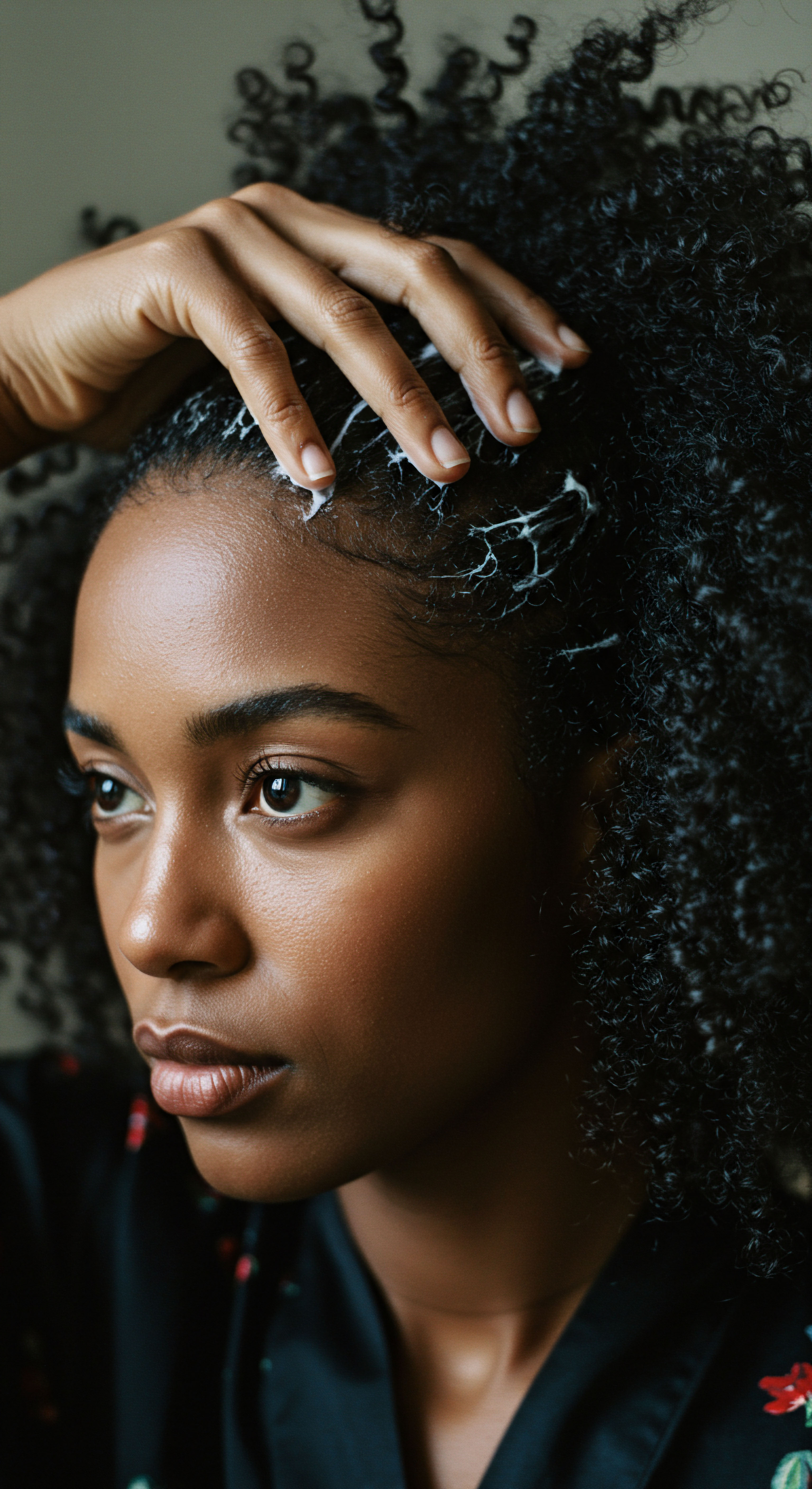
Roots
The quiet hours of night, often overlooked in our bustling days, hold a profound secret for the vitality of our strands. When we settle into slumber, our bodies embark on a meticulous restorative process, a silent orchestration that reaches every corner of our being, including the delicate ecosystem of our scalp follicles. This nightly rhythm, a biological symphony, dictates more about our hair’s future than many might suspect.
It is within this serene repose that the very foundations of hair health are laid, nurtured, or, regrettably, undermined. To truly understand how sleep patterns influence the resilience and growth of textured hair, we must first look to the microscopic world beneath the surface, to the tireless work of cells and the intricate dance of hormones.
Each strand of hair, from its earliest formation, follows a meticulously timed cycle, a rhythm deeply connected to our body’s internal clock, the circadian rhythm. This rhythm governs far more than just when we feel sleepy or alert; it influences cellular repair, hormone production, and even the pace at which our hair cells divide. The hair follicle, a marvel of biological engineering, houses a bustling hub of activity. Here, specialized cells are constantly at work, building, growing, and renewing.

The Follicle’s Inner Clockwork
Within the very heart of the scalp, each hair follicle operates with its own internal timekeeper, a local circadian clock that synchronizes with the grander rhythm of the body. This intrinsic timing mechanism dictates when follicle cells are most active, when they rest, and when they prepare for the next phase of growth. Research has brought to light the astonishing detail of this internal schedule. For instance, studies indicate that the epithelial matrix cells within the hair follicle, responsible for producing the hair shaft, display a prominent daily mitotic rhythm.
This means these cells divide more rapidly at certain times of the day than others. One study, using mouse models, even observed that hairs grew faster in the morning than in the evening, a direct consequence of this circadian mitotic rhythmicity in the hair matrix cells. This specific, time-dependent cellular activity underscores how deeply linked the follicle’s operational efficiency is to the body’s natural sleep-wake cycle.
When sleep is fragmented or insufficient, this delicate follicular clockwork can fall out of sync. The consequence is not merely a tired appearance; it can disrupt the precise timing of cellular proliferation and differentiation, which are essential for healthy hair growth. Consider the dermal papilla, a cluster of specialized cells at the base of the follicle that acts as a conductor, signaling to the surrounding matrix cells to begin the growth phase. These dermal papilla cells also possess their own circadian rhythm, and their ability to send these vital growth signals is optimized during periods of proper rest.
The silent hours of sleep are a profound, often underestimated, foundation for the vitality of scalp follicles.
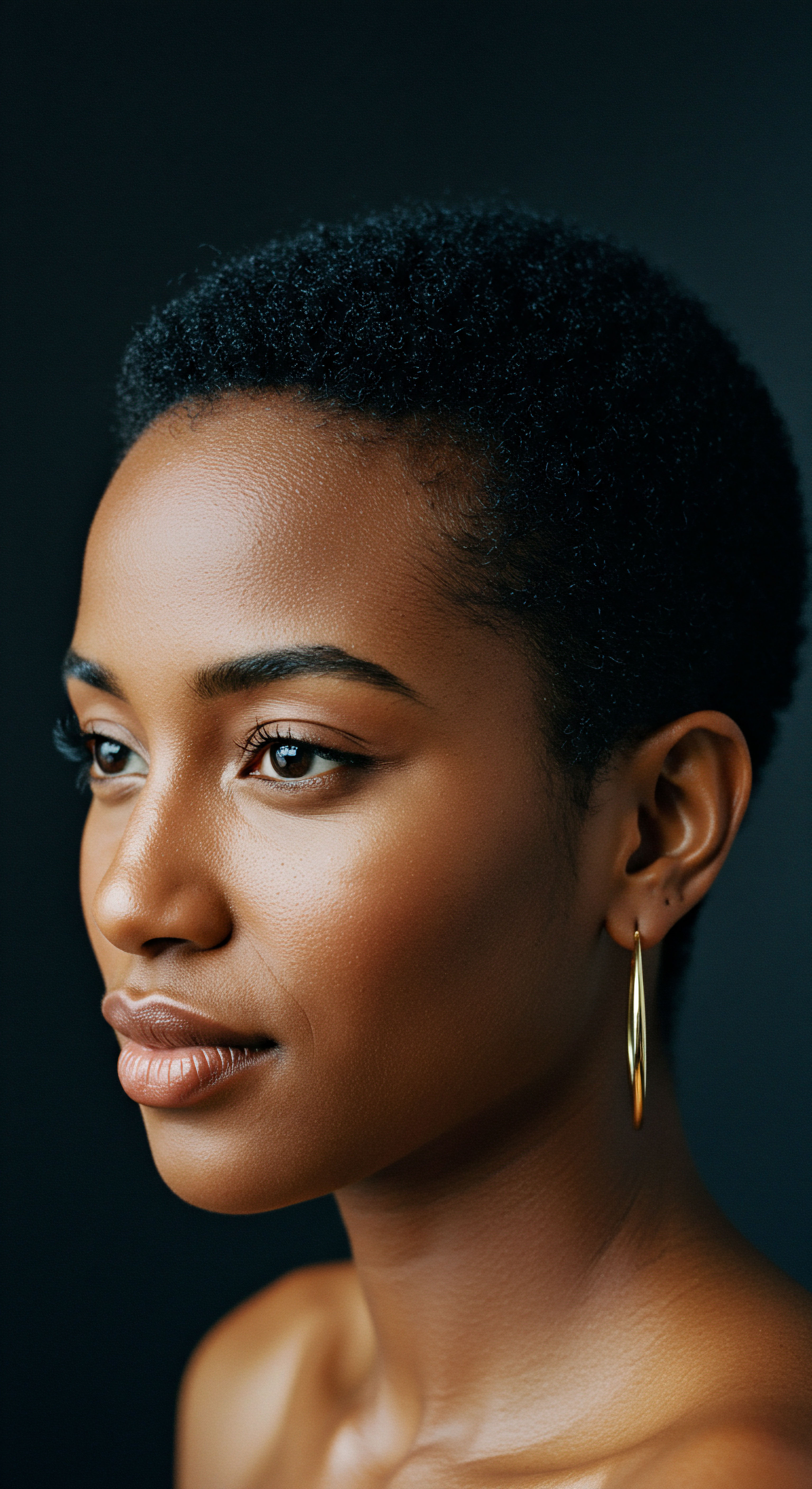
Hormonal Messengers of the Night
The night is a time of hormonal recalibration, and several key chemical messengers directly influence hair follicle health. Among the most prominent are melatonin, cortisol, and growth hormone.
- Melatonin ❉ This hormone, widely recognized for regulating our sleep-wake cycle, plays a direct and significant role in hair growth. Melatonin receptors are present in human hair follicles, suggesting its active participation in the hair growth cycle. Research indicates that melatonin can influence the hair cycle by down-regulating apoptosis (programmed cell death) and regulating gene expression that promotes hair follicle proliferation. Adequate sleep supports the natural production of melatonin, thereby bolstering the follicle’s ability to maintain its active growth phase.
- Cortisol ❉ Often termed the ‘stress hormone,’ cortisol levels naturally fluctuate throughout the day, peaking in the morning and declining at night. Sleep deprivation, however, can disrupt this natural rhythm, leading to chronically elevated cortisol levels. High cortisol can be particularly detrimental to hair follicles. It has been linked to conditions such as telogen effluvium, a form of temporary hair loss characterized by excessive shedding, and can worsen androgenetic alopecia. Cortisol can inhibit growth factors essential for hair production and constrict the tiny blood vessels that supply the scalp, thereby limiting nutrient delivery to the follicles.
- Growth Hormone ❉ The deepest stages of sleep are when our bodies release the majority of growth hormone. This powerful hormone is essential for cellular repair, regeneration, and growth across the entire body, including the hair follicles. It stimulates the production of insulin-like growth factors (IGF-1), which are known to be mitogenic at the dermal papillae, meaning they promote cell division and elongation of hair follicles. A consistent lack of deep, restorative sleep directly impacts the availability of this crucial hormone, potentially slowing hair growth and hindering the follicle’s ability to repair itself.
The interplay of these hormones during restful sleep creates an optimal environment for hair follicle function. When this delicate balance is disturbed, the follicles, despite their inherent resilience, face an uphill battle to maintain their vibrant health.
| Hormone Melatonin |
| Primary Role in Sleep Regulates sleep-wake cycles |
| Influence on Hair Follicles Stimulates hair growth, modulates hair cycle, possesses antioxidant properties |
| Hormone Cortisol |
| Primary Role in Sleep Stress response, circadian rhythm |
| Influence on Hair Follicles Elevated levels linked to telogen effluvium, inhibited growth factors, reduced blood flow |
| Hormone Growth Hormone |
| Primary Role in Sleep Cell repair and regeneration |
| Influence on Hair Follicles Promotes hair growth, stimulates IGF-1 production vital for dermal papilla activity |
| Hormone Balanced hormonal activity during quality sleep is paramount for optimal hair follicle health and hair cycle progression. |

Ritual
The journey to vibrant hair is not merely a matter of what we apply to our strands, but also how we honor our body’s fundamental need for rest. Just as we nourish our hair with enriching ingredients and protective styles, so too must we tend to the nightly rhythm that supports its very growth. The practices we adopt before and during our hours of repose transform from simple routines into profound rituals, shaping the environment for our scalp follicles to thrive. It is in this quiet attention to our sleep patterns that we discover a powerful, yet often overlooked, aspect of hair wellness.
For textured hair, in particular, the nighttime hours present both a challenge and an opportunity. The unique structure of curls and coils makes them more susceptible to friction and moisture loss, making protective nighttime care not merely a suggestion, but a foundational practice. Yet, beyond the external measures, the internal environment created by quality sleep holds even deeper sway.

What Happens to Scalp Blood Flow During Sleep?
During the deeper stages of sleep, our body prioritizes repair and regeneration, a process that includes optimizing blood flow to various tissues, including the scalp. Adequate circulation is the lifeline for hair follicles, delivering the essential oxygen and nutrients they require for active growth and metabolic processes. When sleep is consistently disrupted, this vital supply chain can be compromised.
Studies suggest that sleep deprivation can hinder blood circulation throughout the body, including the scalp, potentially limiting the delivery of these critical elements to the hair follicles. A well-nourished follicle is a healthy follicle, capable of producing strong, resilient strands.
Think of it as the irrigation system for a garden; if the water supply is irregular or insufficient, the plants will struggle to flourish. Similarly, if the scalp’s blood flow is diminished due to poor sleep, the hair follicles may not receive the consistent nourishment needed to sustain the anagen (growth) phase of the hair cycle. This can lead to weaker hair, slower growth, and even premature shedding.
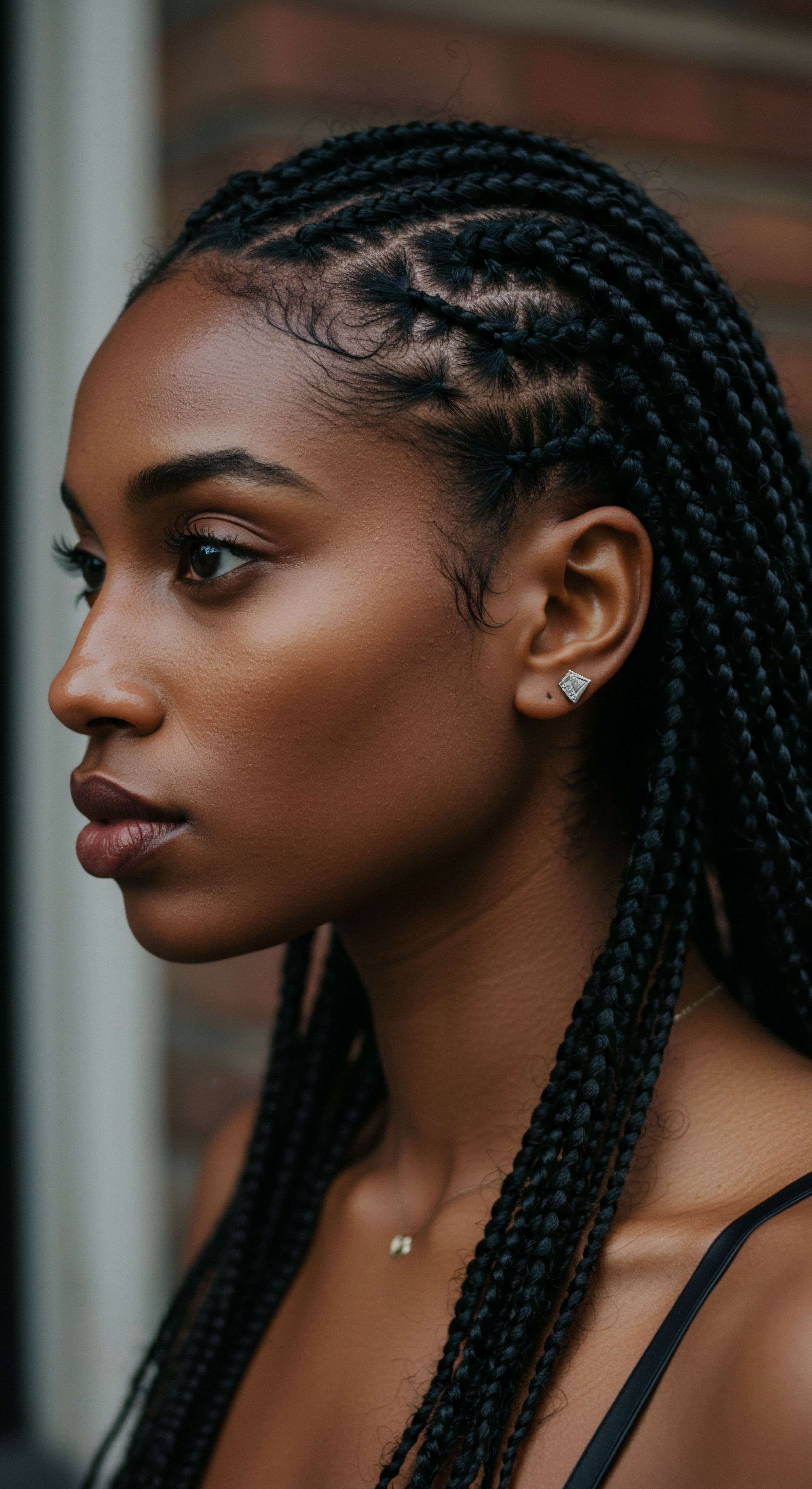
Can Consistent Sleep Patterns Reduce Telogen Effluvium?
One of the most direct links between sleep patterns and hair health manifests in conditions like telogen effluvium, a temporary hair loss often triggered by significant stress or disruption to the body’s systems. When sleep is consistently insufficient or irregular, it elevates stress hormones, particularly cortisol. This prolonged elevation can prematurely push a greater number of hair follicles from their active growth phase into the resting (telogen) phase, leading to noticeable shedding.
A consistent sleep schedule, conversely, aids in regulating these stress responses, allowing cortisol levels to normalize. By fostering a state of calm and allowing the body to properly restore itself, consistent sleep helps maintain the hair follicles in their active growth phase for longer, thereby reducing the likelihood of premature shedding. It is a proactive step in managing the body’s stress load, which directly translates to a more stable and robust hair growth cycle.
Thoughtful nighttime practices and consistent sleep patterns offer a sanctuary for scalp follicles, promoting their health and resilience.
For individuals with textured hair, integrating thoughtful nighttime care into a consistent sleep ritual becomes doubly important. This includes not only protecting the hair from mechanical damage but also optimizing the internal environment through restful sleep.
- Protecting Strands ❉ Wrapping hair in a Satin Bonnet or sleeping on a Silk Pillowcase minimizes friction, preserving moisture and preventing breakage that can exacerbate the appearance of thinning or slow growth.
- Scalp Massage ❉ A gentle Scalp Massage before bed can help stimulate blood flow, a practice that aligns with the body’s natural restorative processes during sleep, delivering more oxygen and nutrients to the follicles.
- Mindful Routines ❉ Establishing a calming bedtime routine, free from screens and stimulating activities, signals to the body that it is time to wind down, supporting the natural release of sleep-inducing hormones like melatonin.
These practices, when combined with genuine, restorative sleep, form a powerful alliance for the health of scalp follicles, allowing them to regenerate and prepare for another day of vibrant growth.

Relay
Beyond the surface-level observations of hair vitality, a deeper understanding of sleep’s influence on scalp follicles compels us to consider a complex interplay of biological signals, cellular rhythms, and even cultural perspectives. The connection extends far beyond simply getting enough hours; it delves into the very machinery of cellular regeneration, the delicate balance of neuroendocrine systems, and the profound impact of our lived experience on the microscopic world of the follicle. This is where the wisdom of ancient practices meets the precision of modern science, illuminating the interconnectedness of our overall wellbeing with the health of our hair.

How Does Circadian Rhythm Disruption Affect Hair Follicle Stem Cells?
The human body, including its hair follicles, operates on a roughly 24-hour cycle known as the circadian rhythm. This internal clock is regulated by core clock genes present in almost every cell, including those within the hair follicle. These genes orchestrate the timing of various physiological processes, from cell division to hormone secretion. When this rhythm is disrupted, as seen in individuals who work night shifts or experience chronic sleep disturbances, the consequences for hair follicles can be significant.
Studies have indicated that long-term deregulated circadian rhythm can affect the regenerative properties of human skin and hair precursor cells. Specifically, the rhythmic expression of core clock genes like BMAL1 and PER1 within hair follicle stem cells and dermal papilla cells is crucial for proper hair cycle progression. When BMAL1 is knocked down in dermal papilla cells, for instance, there are significant decreases in the expression of hair-growth-related genes such as WNT10B, LEF1, STAT3, and BMP4. This disruption can lead to an anagen phase delay, meaning the hair’s active growth period is shortened, potentially resulting in thinner hair and increased shedding.
Consider the implications for individuals engaged in shift work, where consistent disruption to natural sleep-wake cycles is inherent. Research on military personnel exposed to operational stressors, including sleep deprivation and fatigue, has shown that hair follicles can serve as a robust biomarker system for assessing corresponding adaptations in gene expression profiles. This suggests that chronic circadian misalignment, a common consequence of such work, can indeed leave its molecular signature on the hair follicle, affecting its fundamental regenerative capacity. While not everyone working a night shift will experience hair loss, the physiological stressors associated with it can create a less than optimal environment for sustained hair growth.
Disruptions to the body’s circadian rhythm can directly impact the regenerative capabilities of hair follicle stem cells, affecting growth patterns.

What is the Interplay of Neuroendocrine Factors and Follicle Health During Sleep?
The neuroendocrine system, a complex network of glands and hormones, plays a critical role in mediating the relationship between sleep and hair health. Beyond cortisol and melatonin, other hormones like prolactin, thyroid hormones, and even androgens are influenced by sleep patterns and, in turn, affect the hair growth cycle.
For instance, the synthesis of certain cell growth hormones is often concentrated during the night. When nighttime rhythms are disrupted, the production of these growth hormones, including those that manage hair growth, can be impaired. This hormonal imbalance can deregulate the hair’s vital cycle, leading to insufficient blood supply to the hair follicle and compromised growth.
A particularly interesting aspect involves the relationship between sleep, stress, and specific types of hair loss, such as alopecia areata. While the exact mechanisms are still under investigation, a 2022 study involving 102 adults, half with severe alopecia areata and half without, suggested a complex connection between the condition and sleep issues, including less than six hours of sleep, high stress scores, and obstructive sleep apnea. The researchers noted that insufficient sleep can act as a trigger for various autoimmune disorders, and alopecia areata frequently co-occurs with other autoimmune conditions. This implies a deeper, systemic connection where sleep deprivation may compromise immune regulation, potentially exacerbating autoimmune responses that target hair follicles.
Furthermore, hair cortisol concentration (HCC) has emerged as a non-invasive biomarker for assessing long-term stress levels. Studies have shown that HCC is significantly higher in individuals experiencing major chronic stress. Given the well-established link between chronic stress and hair loss, particularly telogen effluvium, measuring HCC offers a compelling way to objectively quantify the physiological impact of sleep deprivation-induced stress on the body and, by extension, on hair follicle health. The sustained, non-resolving inflammation that can result from chronic stress and cortisol dysregulation can disrupt cell signaling pathways that maintain the health of the hair follicle and its normal cycle transitions.
| Factor of Disruption Circadian Misalignment (e.g. Shift Work) |
| Physiological Effect Altered clock gene expression (BMAL1, PER1) in follicle cells |
| Consequence for Hair Follicles Delayed anagen phase, impaired regenerative capacity of stem cells |
| Factor of Disruption Elevated Cortisol |
| Physiological Effect Inhibited growth factors, reduced blood flow, pro-inflammatory state |
| Consequence for Hair Follicles Premature telogen entry, increased shedding (telogen effluvium), potential exacerbation of androgenetic alopecia |
| Factor of Disruption Reduced Growth Hormone |
| Physiological Effect Decreased cellular repair and regeneration |
| Consequence for Hair Follicles Slower hair growth, compromised follicle repair mechanisms |
| Factor of Disruption Impaired Blood Circulation |
| Physiological Effect Limited oxygen and nutrient delivery to scalp |
| Consequence for Hair Follicles Weaker hair, inhibited growth, miniaturization of follicles |
| Factor of Disruption Chronic sleep disruption triggers a cascade of physiological changes that collectively undermine the optimal function and vitality of scalp follicles. |
This deeper lens reveals that the health of our hair follicles is not an isolated concern but a reflection of our overall physiological harmony. The wisdom of cultures that prioritize rest and restorative practices, such as traditional hair oiling rituals often performed before sleep, gains new scientific credence when viewed through the lens of hormonal balance and cellular repair. These ancient rituals, often steeped in community and gentle care, instinctively supported the conditions necessary for thriving hair, recognizing that the body’s nighttime restoration is a sacred process.
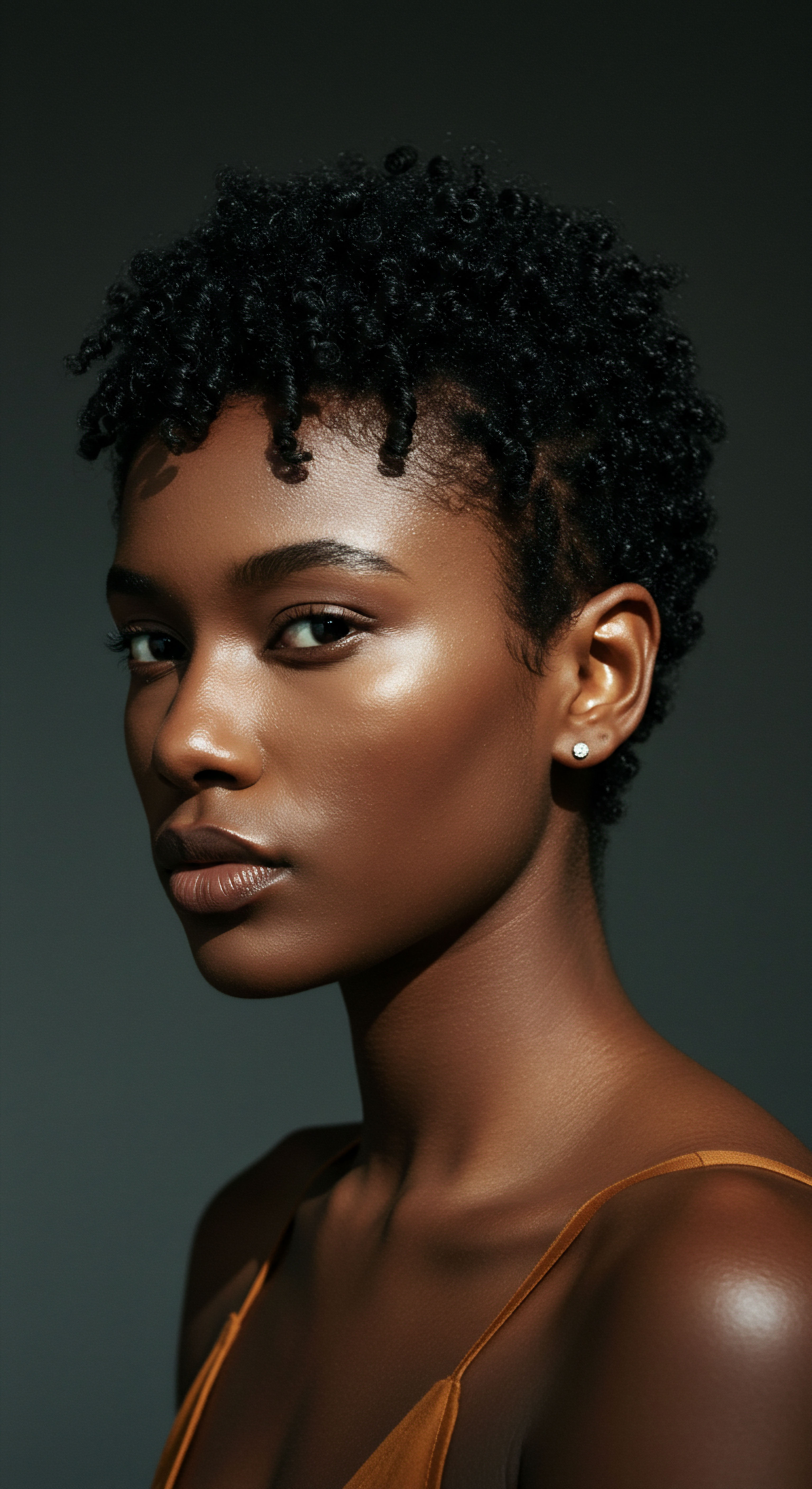
Reflection
As the quiet of night descends, our bodies embark on a journey of profound renewal, a subtle yet powerful process that extends to the very roots of our hair. The intricate dance of hormones, the precise rhythm of cellular repair, and the steady flow of life-giving nutrients are all orchestrated within the hours of our slumber. For those with textured hair, this nocturnal period holds a special significance, offering a unique opportunity for restoration and protection.
By truly honoring our body’s need for deep, restorative rest, and by embracing thoughtful nighttime rituals, we cultivate not only stronger, more radiant strands but also a deeper connection to our inherent rhythms and wellbeing. The whispers of our follicles, speaking of growth and resilience, are often heard most clearly in the gentle silence of a well-rested night.
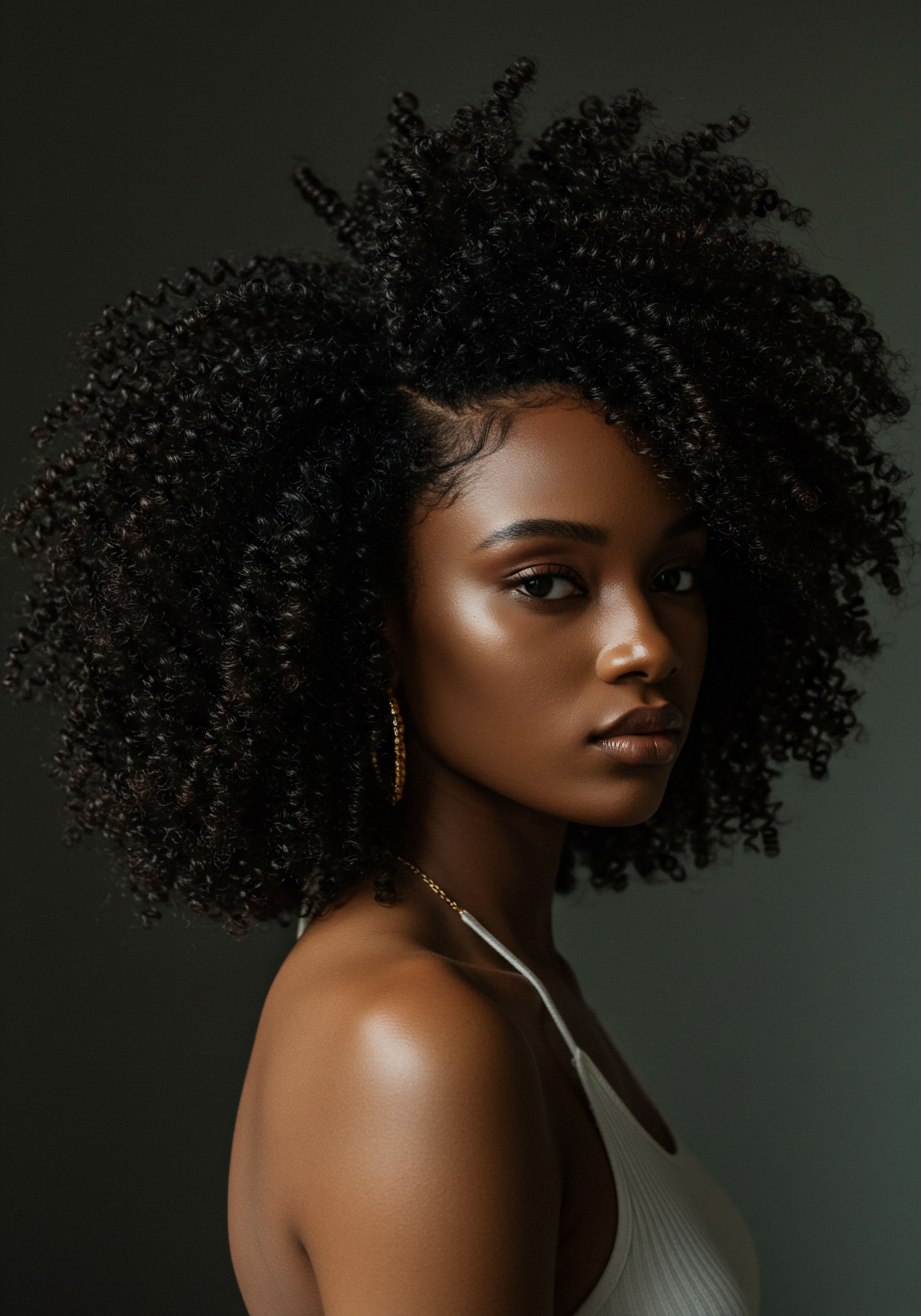
References
- Chen, D. Li, S. Wang, T. Li, J. Yang, Z. Zhang, J. & Zhang, M. (2023). Melatonin’s Role in Hair Follicle Growth and Development ❉ A Cashmere Goat Perspective. Animals, 13(13), 2133.
- HHC Clinics. (2024). Sleep and Hair Growth – What’s the Connection? Medically reviewed by Dr Ali.
- Clinikally. (2024). Impact of Sleep Deprivation on Hair Health.
- HairFree & HairGrow. (2023). Sleep and Hair Loss. Relationship Explained.
- Centre Clauderer. (n.d.). Hair and sleep ❉ the importance of the night for hair health.
- Treatment Rooms London. (2024). Can A Lack of Sleep Cause Hair Loss?
- The Hairology Centre. (2024). Can Shift Work Cause Hair Loss?
- Fischer, T. W. Burmeister, G. Schmidt, N. & Elsner, P. (2012). Melatonin and the Human Hair Follicle. Journal of Drugs in Dermatology, 11(2), 253-256.
- MONPURE. (2024). Hair Loss ❉ Is Lack of Sleep Stunting Growth?
- Hiro Clinics. (2024). Relationship Between AGA and Sleep Quality.
- Birmingham Dermatology Clinic. (n.d.). Melatonin stopping hair loss?
- Healthline. (2024). Does Melatonin Cause Hair Loss? What Research Shows.
- Slominski, A. Wortsman, J. Tobin, D. J. Zmijewski, M. A. Zbytek, B. Sugawara, K. & Steketee, R. (2005). Melatonin and the hair follicle. Journal of Pineal Research, 38(3), 167-171.
- AllThingsBeauty. (2023). Does Working the Night Shift Cause Hair Fall.
- Geyfman, M. Kumar, V. Sato, S. & Millar, S. E. (2013). Local circadian clock gates cell cycle progression of transient amplifying cells during regenerative hair cycling. Proceedings of the National Academy of Sciences, 110(24), 9923-9928.
- Kumar, R. (2023). The Bonding Ritual of Hair Oiling. Brown History.
- Geyfman, M. Kumar, V. Sato, S. & Millar, S. E. (2013). Local circadian clock gates cell cycle progression of transient amplifying cells during regenerative hair cycling. PNAS, 110(24), 9923-9928.
- Wang, J. Ma, C. Liu, C. Yang, Y. & Zhao, S. (2023). Overview of the Circadian Clock in the Hair Follicle Cycle. Cells, 12(13), 1787.
- Geyfman, M. Kumar, V. Sato, S. & Millar, S. E. (2013). Epithelial matrix and dermal papilla constitute key sites of circadian activity in anagen hair follicles. ResearchGate.
- National Institutes of Health (NIH). (2021). How stress causes hair loss.
- Psych Central. (2022). PsychoHairapy ❉ A Ritual of Healing Through Hair.
- Zhang, J. Wallace, S. J. Smith, I. Shiu, M. Y. DiBattista, A. P. Powlesland, C. & Langlois, V. S. (n.d.). Hair follicle gene expression profiling ❉ A novel system for exploring biomarkers in military operational stress disorders. Hilaris Publisher.
- Karlén, J. Ludvigsson, J. Hedner, N. & Faresjö, M. (2011). Elevated content of cortisol in hair of patients with severe chronic pain ❉ A novel biomarker for stress. Stress, 14(1), 107-111.
- Belgravia Centre. (2015). Can We Really Rule Out Link Between Night Shifts and Hair Loss?
- Harley Street Hair Clinic. (n.d.). Emotional stress and hair loss.
- Rupa Health. (n.d.). Understanding the Link Between Cortisol & Hair Loss.
- National Post. (2016). The night shift killed my memory, mood, and hair.
- Zmijewski, M. A. Slominski, A. T. Zbytek, B. & Tobin, D. J. (2009). Mitotic progression in hair-follicle matrix shows circadian rhythmicity. ResearchGate.
- Haryanto, A. & Pratiwi, H. (2023). The Role of Cortisol in Chronic Stress, Neurodegenerative Diseases, and Psychological Disorders. Journal of Psychiatry and Mental Health, 7(2), 221-232.
- Hims. (2024). Does Lack of Sleep Cause Hair Loss?
- Rossi, A. Fortuna, M. C. & D’Arino, A. (2020). The role of sleep in telogen effluvium and trichodynia ❉ A commentary in the context of the current pandemic. Journal of Clinical and Aesthetic Dermatology, 13(9), 48–50.
- Aburto, L. L. & Karita, M. K. (2023). Non-invasive circadian clock detection with hair follicle cells ❉ a review. ResearchGate.
- Occupational Cancer Research Centre. (n.d.). Notes on shift work and health.
- Castelnovo, A. Riedner, B. A. Smith, R. F. Tononi, G. Boly, M. & Benca, R. M. (2018). Scalp and Source Power Topography in Sleepwalking and Sleep Terrors ❉ A High-Density EEG Study. Sleep, 41(8), zsy096.
- Prather, A. A. & Epel, E. S. (2018). Investigating relations among stress, sleep and nail cortisol and DHEA. Stress, 21(1), 8-15.
- Zhang, J. Wallace, S. J. Smith, I. Shiu, M. Y. DiBattista, A. P. Powlesland, C. Rhind, S. G. & Langlois, V. S. (2015). Identification of hair cycle-regulated genes using probabilistic. ResearchGate.
- Strand Books. (n.d.). Hair Regrowth Secrets ❉ Unlocking the Power of Nature and Science for Fuller, Thicker Hair.
- Orlando Pita Play. (2023). Haircare Rituals Around the World ❉ Exploring Global Traditions.
- Riedner, B. A. Smith, R. F. & Tononi, G. (2019). Scalp and hippocampal sleep correlates of memory function in drug-resistant temporal lobe epilepsy. Sleep, 42(6), zsz059.
- Starace, M. & Alessandrini, A. (2020). Integrative and Mechanistic Approach to the Hair Growth Cycle and Hair Loss. Cosmetics, 7(3), 64.
- BBC. (2022). The revival of ancient beauty rituals.
- O’Connor, R. M. & Zmijewski, M. A. (2014). Day–night cycles and the sleep-promoting factor, Sleepless, affect stem cell activity in the Drosophila testis. Proceedings of the National Academy of Sciences, 111(16), 5942-5947.
- Wikipedia. (n.d.). Pattern hair loss.
- Montagna, W. (1958). The Biology of Hair Growth. Academic Press.
- HCPLive. (2025). Hair, Scalp Health Linked to Perceived Stress and Sleep Quality.
- VIORI Shampoo Bars. (2022). 5 Hair Rituals From Around the Globe.
- Randall, V. A. (2008). The Biology and Genomics of Human Hair Follicles ❉ A Focus on Androgenetic Alopecia. Endocrine Reviews, 29(4), 481-512.